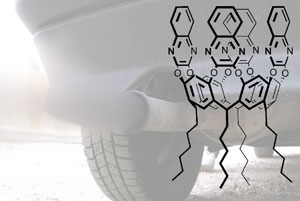| Posted: June 7, 2007 |
Molecular sensor for harmful organics |
|
(Nanowerk News) Monitoring levels of organic contaminants in roadside air is now possible thanks to a supramolecular approach developed by Italian scientists ("A supramolecular approach to sub-ppb aromatic VOC detection in air" – free access article).
|
|
Molecular cavities are used to trap harmful aromatic compounds, such as the carcinogen benzene, enabling the detection of contaminants at concentrations lower than parts per billion (ppb).
|
 |
|
Measuring sub-ppb concentrations of airborne organic contaminants is difficult as readings can be swamped by compounds, like water vapour, that are present in high and variable concentrations. Current metal oxide gas sensors are not selective enough to detect organic molecules.
|
|
By trapping and concentrating the aromatic organic compounds in a supramolecular cavity, Enrico Dalcanale, Stefano Zampolli and colleagues at the University of Parma and the National Research Council, Bologna, have designed a sensor capable of detecting low levels of aromatic organic contaminants.
|
|
'The main drive for this development is to provide low-cost, stand-alone sensor systems for outdoor pollution monitoring, in particular to track the concentrations of benzene,' said Dalcanale.
|
|
The sensor is palm-sized and connected to a detector composed of a micromachined gas chromatographic column and metal oxide sensor array. The result of the combination of supramolecular sensor and detector is increased selectivity and a reduction in the detection limits.
|
|
'The system automatically performs sampling, injection, separation and cleaning steps and the sampling phase has a typical duration of 10-60 minutes,' said Dalcanale. 'So it measures volatile organic compounds, stand-alone and in real-time, as an average value over the sampling period.'
|
|
The supramolecular trap, a quinoxaline-bridged cavitand, is a bowl-like structure with a cavity about eight Ångstroms deep and wide. The cavitand has two roles - it separates the aromatic compounds from other pollutants and interferents in the air and it concentrates the aromatic organic compounds to a level sufficient to be detected by the metal oxide sensor.
|
|
As the cavitand only traps aromatic compounds, it is insensitive to aliphatic carbons, water and polluting gases such as carbon monoxide and nitrous oxides. However, the same system could be adapted for other applications by tailoring the supramolecular receptor to the desired analyte.
|
|
'The selectivity of the new approach is a real breakthrough: the single aromatic volatile organic compounds are chromatographically separated and quantified,' said Dalcanale. 'The proposed sensor system is very small, easy to use and shows exceptional performance in the sub-ppb range.'
|
|
Franz Dickert, an analytical chemist at the University of Vienna, Austria, praised the strategy and thought the sensor could be used in workplace monitoring. 'A pre-concentration or a pre-selection will improve the sensitivity and selectivity of the sensor, in contrast to chromatography in sensors where there is only one separation step,' said Dickert.
|
|
Dalcanale and co-workers are actively collaborating with local environmental protections agencies and the system is currently being validated in the field.
|

